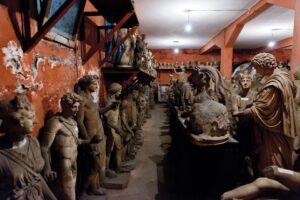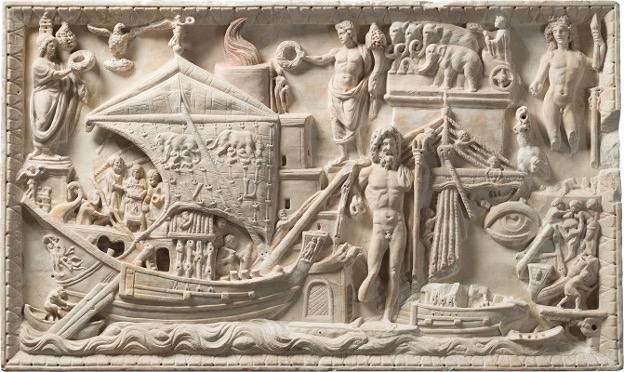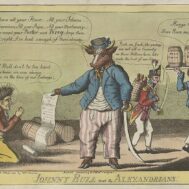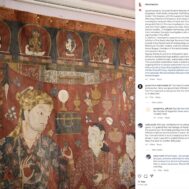UPDATE! The February 4, 2005 hearing on renewal of MOUs with Italy, Chile and Morocco and a new proposed MOU with Vietnam was cancelled on January 31! The State Department’s Cultural Heritage Bureau stated that the hearing would be rescheduled, and that there would be additional time for comments and public testimony when it was. However, no date has been set. Stay posted for future updates on Cultural Property News!
Committee for Cultural Policy, Inc. and Global Heritage Alliance
Written Testimony Submitted to Cultural Property Advisory Committee on the Proposed Twenty-Fifth Year Renewal of the Memorandum of Understanding Between the United States of America and the Italian Republic
Submitted January 24, 2025 for Hearing February 4, 2025
The Committee for Cultural Policy (CCP)[1] and Global Heritage Alliance (GHA)[2] respectfully submit this testimony regarding the proposed extension of the Memorandum of Understanding (MOU) on import restrictions between the United States and Italy. While we fully support the objectives of the 1983 Cultural Property Implementation Act (CPIA)[3], we oppose import restrictions that fail to meet statutory criteria and harm U.S. stakeholders.
MOUs were not intended to last forever. Twenty-five years is certainly long enough for a country to get it together to improve its cultural enforcement and plan for site protections. In fact, for the most part, Italy has done so.
Over the past two and a half decades, U.S. museums, art dealers, and collectors have faced severe limitations on acquisitions of art of Italian origin. Renewing the MOU without substantive evidence of its effectiveness would perpetuate an embargo that does not apply to Italian or EU buyers, disadvantaging U.S. citizens. If coins are included in the agreement, countless small businesses reliant on the lawful trade of internationally circulated coins will suffer unnecessary and disproportionate economic harm.
Since the MOU’s inception in 2001, Italy has not provided measurable goals or data demonstrating the effectiveness of restrictions. Without such accountability, U.S. stakeholders lack meaningful opportunities for cultural exchange or evidence that the MOU deters looting.
Rule of Law and CPIA Compliance
The Committee advocates for strict adherence to the CPIA, which governs the Cultural Property Advisory Committee (CPAC). The CPIA establishes clear legal standards for agreements like the MOU, requiring that each one meets specific criteria. Renewing the MOU without substantial evidence that these criteria are met would breach CPAC’s legal obligations.
The CPIA was never intended to establish perpetual MOUs. Congress envisioned import restrictions as temporary measures subject to periodic review and renewal only if evidence supports their necessity. Under Section 2602 of the CPIA, four specific determinations must be satisfied before imposing or renewing import restrictions:
-
Jeopardy to Archaeological Resources
Italy must demonstrate that its archaeological resources are currently in jeopardy from looting. This requires statistical evidence, data from seizures and proof that the U.S. is a primary market for Italian antiquities looted over the past five years. However, Italy’s Carabinieri have done a pretty good job, so much so that looting within Italy is very much reduced and on the way to ending, at least as far as commercial looting is concerned.
Italy has provided no substantive evidence of current widespread pillage for any items on its Designated List. This list also includes objects whose origins extend beyond Italy’s borders. Under the CPIA, import restrictions apply only to items “first discovered” within the requesting country and illicitly exported after the effective date of governing regulations. There should be a specific exclusion for Roman Imperial coins, which are found much more commonly outside of Italy.
Currently, U.S. Customs and Border Protection (CBP) applies restrictions far beyond the CPIA’s intent, creating a de facto embargo on all items on the Designated List. CPAC must clarify that restrictions only apply prospectively to objects illicitly exported from Italy, found within its borders, and subject to Italian export controls, amending any Designated List to conform to the statute.
-
Measures to Protect Cultural Patrimony
Italy’s efforts to recover objects from foreign museums and private collections do not fulfill the CPIA’s requirements. The CPIA mandates that Italy take proactive domestic measures to protect cultural patrimony by funding preservation efforts, enforcing site protection, and curbing looting. However, Italy falls short in several areas:
- Funding Deficits: The key losses Italy is suffering is through erosion, harsh climactic conditions, and more than anything else, neglect.
- Italy spends among the least in Europe on cultural heritage preservation. The lack of government investment leaves many archaeological sites, historical buildings, and museums vulnerable to theft, decay, and neglect. Much of what has been spent in Italy for site preservation and restoration has come from the USA and from other EU countries, notably in the restoration of Pompeii.
- The vast majority of artifacts “stolen” in Italy today do not come out of the ground. They are taken from institutions by insiders, filching ancient books from libraries and secondary artworks form storage facilities that have never been inventoried. This highlights the inadequacy of resources devoted to site and museum security.
- Privatization of Restoration: As it has in previous years, the amount spent by the Government of Italy is dropping and access to illustrious settings for advertising and brand promotion continues to increase in exchange for corporate funding. While promotional enterprises can help to restore famous monuments, the ordinary requirements of preservation are left behind. Private sponsorships from corporations, such as luxury brands that use cultural heritage for advertising and promotional purposes are focused on world-famous monuments. While these contributions are valuable, they fail to address systemic underfunding or protect lesser-known sites and artifacts.
Meeting CPIA criteria requires Italy to take active steps to safeguard its cultural patrimony within its borders, not rely on external funding, corporate sponsorships, or retrospective claims against long-exported artifacts.
-
Concerted International Response and Alternatives to Import Restrictions
The CPIA mandates that import restrictions align with similar efforts by other nations and significantly benefit efforts to deter looting. Italy’s approach, however, lacks broad international cooperation and fails to consider viable alternatives to restrictions:
- EU Import Policies: Regulation (EU) 2019/880 of the European Parliament and of the Council of 17 April 2019 will come into effect this April. It will exempt objects originating within the EU, allowing freer circulation of Italian artifacts across Europe but restricting certain exports to the U.S.[4] This undermines the notion of a coordinated international response to protect cultural heritage.
- Italy is part of the EU and legal exports from the EU of items on the Designated List should be allowed to freely enter the U.S.
- Viable Alternatives: Establishing a regulated, government-supervised market for redundant or duplicative antiquities could reduce looting and generate funds for Italy’s underfunded cultural sector. Transparent markets have proven effective in curbing illegal trade by meeting international demand for cultural artifacts.
-
General Interest in Cultural Exchange
The CPIA requires that restrictions serve the general interest of the international community in the interchange of cultural property. CPAC must balance the need to protect heritage with the broader benefits of cultural exchange. However, restrictive policies often undermine this balance.
CPAC has sometimes equated import restrictions with moral imperatives to stop looting, disregarding the CPIA’s intent to facilitate cultural exchange alongside heritage protection. It is axiomatic that a lawful market very soon puts an unlawful market out of existence, and the adoption by Italy of a documented, transparent market under official supervision that utilized only a small number of the hundreds of thousands of duplicative antiquities now held in ill-protected and undocumented storage would soon satisfy the international demand for its antiquities.
Mark B. Feldman, who was the primary State Department negotiator on the CPIA has said:
…there have been dramatic changes in U.S. law and practice that have established a very different policy balance than the one the State Department negotiated in the UNESCO Convention and that Congress approved in the implementing legislation.[5]
And
In recent years, the State Department has implemented the program vigorously believing strongly in its mission to help protect the cultural heritage of mankind and responding to the demands of foreign states. This is commendable provided the Department complies with its statutory mandate. The Executive is not authorized to establish import controls without international cooperation unless an emergency condition exists as defined by law, and Congress did not intend to authorize comprehensive import controls on all archeological objects exported from a country of origin without its permission. The purpose of the program is not to keep art at home, but to help protect archeological resources from pillage; the findings required by the CCPIA were established for that purpose.[6]
Lack of Transparency and Commitment to Collaboration
Italy asserts a commitment to combating illicit trafficking in cultural property in partnership with American museums and art businesses. However, it has consistently failed to provide critical information about stolen objects to museums, auction houses, and the legitimate art trade. This lack of transparency persists despite repeated requests from organizations such as the Association of Art Museum Directors (AAMD), dealer associations, and auction houses over the past decade.
In its 2015 submission during the third renewal of the MOU with Italy, the AAMD emphasized Italy’s failure to uphold transparency commitments. It stated:
A recent issue raises concerns about Italy’s commitment to protecting its cultural heritage from illegal transfers on the open market. Specifically, Italy has not made available the dossier of Gianfranco Becchina, a well-known Italian art dealer charged with (although not convicted of) illicit antiquities trafficking. The Becchina dossier is said to be made up of ‘over 7,400 photographs of relics . . . and 13,000 documents in 140 binders’; in short, meticulous records of Becchina’s dealings that spans his career as an art and antiquities dealer. Swiss authorities discovered the dossier in 2001 and shared it with Italian investigators, yet Italy continues to withhold substantially all of its contents.[7]
This serious failure on Italy’s part to share needed information continues. Despite the passage of nearly 25 years since the Becchina and equally comprehensive Medici dossiers were compiled, Italy has failed to make these archives publicly available and U.S. museums are blamed for acquiring objects that they had no opportunity to investigate. Instead, Italy selectively shares the information with archaeologists and self-described “antiquities hunters.”
Aggressive Seizures and Misuse of Withheld Information
By failing to make these archives public, the Government of Italy has encouraged highly publicized seizures of objects tied to the archives when they surface in museum exhibitions, private collections, or auctions. However, the owners of these objects—museums, collectors, or dealers—are denied access to this vital information, leaving them vulnerable to public accusations and reputational harm. This selective sharing of information undermines trust and places the art trade and museums at a significant disadvantage.
Italy’s refusal to provide comprehensive access to its archives has eroded relationships with museums and undermined efforts to foster meaningful partnerships between Italian and U.S. cultural institutions. Italy’s selective sharing of information appears politically motivated, driven by anti-collecting agendas and self-promotion rather than finding constructive solutions to combat trafficking.
The stories of U.S. collectors and museums who acquired antiquities many years ago that are now claimed to come from these non-public archives are trotted out in the press as if they demonstrated a continuing illegal trade. U.S. prosecutors bring high pressure cases against museums for objects that have been in collections for 30-40-and 50 years or more.
European museums, not subject to the same import restrictions as in the U.S., have been more willing to criticize the Carabinieri’s high-handed tactics. Questionable, long-ago cases are also being brought by against collections in Europe. A bronze Hercules was seized by Italian authorities from a loan exhibition from the Antikenmuseum Basel und Sammlung Ludwig at the 17th century Reggia di Venaria Real near Turin in 2018.[8] The statuette had been featured on the catalog cover and in exhibition publicity. The local Turin judiciary, was said to be pursuing a criminal case against the Basel museum.[9] Ten more objects were ordered held in situ for years in the Antikenmuseum pursuant to Italian claims.[10]
The Basel Zeitung quoted the museum’s director, Andrea Bignasca, as noting that the Carabinieri’s handling of the objects resulted in a breach of the museum’s insurance policy. Bignasca, told Coins Weekly that, “So far, Italy has been unable to substantiate the allegations or provide evidence to support that our works were acquired illegally.” The Swiss seizure came to nothing, legally, but the Carabinieri never returned the Hercules Statue.[11]
Recommendations for Improvement
For Italy to genuinely collaborate with the international community, it must prioritize transparency by:
- Publicizing Archives: Make the Becchina, Medici, and similar dossiers publicly available to legitimate stakeholders.
- Enabling Due Diligence: Share critical information with museums, auction houses, and collectors to facilitate informed decisions.
- Fostering Constructive Collaboration: Move away from public relations tactics and toward meaningful cooperation that strengthens partnerships.
By adopting these practices, Italy can enhance its role as a responsible steward of cultural heritage while building trust with the global community.
Insufficient Cooperation with American Museums on Loans
Renewed restrictions should prioritize broader cultural cooperation and educational opportunities. “The general interest of the international community in the interchange of cultural property among nations” is a broad concept tied to the circulation of art and ideas, not the furtherance of archaeology alone. Despite frequent administrative challenges, including unclear decision-making processes in Italy, U.S. museums consistently engage with Italian counterparts. According to the AAMD, U.S. museums often loan as many—or more—artworks to Italian institutions as they receive in return. Moreover, American museums frequently contribute to research, documentation, and preservation efforts in Italy.
Despite good-faith efforts by American museums to follow Italy’s complicated regional loan rules, Italy often fails to facilitate loans of objects for U.S. exhibitions. Borrowing works from Italy remains notoriously difficult and expensive for U.S. museums due to:
- Lack of Transparent Procedures: Italy has not established uniform guidelines for international loan requests, leading to inconsistent and cumbersome processes.
- High Loan Costs: Excessive courier and related fees make loans prohibitively expensive, especially for smaller institutions.
Such practices contradict past MOUs, which called on Italy to simplify loan processes and reduce financial barriers. U.S. policies under the MOU should not permit Italy to delay, obstruct, or impose excessive costs on loans, as these practices hinder cultural exchange and undermine the MOU’s objectives.
Italy claims to support the exchange of archaeological materials for cultural, educational, exhibition, and scientific purposes. However, after two decades of MOUs, evidence suggests otherwise. Loans are primarily limited to major U.S. museums that have restituted objects to Italy, leaving smaller museums and institutions excluded. This narrow scope prevents broader public access to Italy’s cultural heritage.
To address these challenges, CPAC should require Italy to demonstrate its commitment to cultural exchange by:
- Tracking Loan Data: Provide detailed records of objects loaned to U.S. museums and the terms of such loans.
- Improving Accessibility: Simplify loan procedures and standardize fees to encourage broader participation by U.S. institutions.
- Promoting Equity: Expand loan opportunities beyond major institutions to include smaller museums and developing nations.
- Aligning Import Restrictions with Cultural Exchange
U.S. import restrictions continue to cover items available for sale within Italy. CPAC should insist that Italy verify its commitment to legal cultural exchanges by including data on export permits granted for antiquities in its request.
Issues with Coins on the Designated List
Ancient coins, among the most commonly found artifacts, pose unique challenges under the CPIA. Many coins included on the Designated List are legally sold within Italy and across the EU. Prohibiting their import into the U.S. contradicts the CPIA’s requirements and disrupts legitimate trade.
The Coin Hoards of the Roman Empire Database[12] documents over 14,000 hoards containing more than 6 million coins. Only 5.24% of these hoards were found within modern Italy, underscoring that Roman coins cannot be presumed to originate there.[13] Since the first MOU with Italy in 2001, and during subsequent renewals in 2005, 2011, 2016, and 2021, CPAC has consistently considered these facts and concluded that import restrictions on late Roman Republican and Roman Imperial coins are inappropriate. The evidence overwhelmingly shows that such Republican and Roman Imperial coins cannot be assumed to be “Italian cultural property” when the vast majority of recorded specimens were found outside modern Italy.
To comply with the CPIA, import restrictions on coins should apply only to items proven to have been “first discovered” in Italy and subject to Italian export controls.
Recommendations for the Future
If the MOU is renewed, CPAC must insist on enforceable commitments that address deficiencies in past agreements. Key recommendations include:
- Restrict import restrictions to objects “first discovered” in Italy and subject to looting.
- Italy should establish a framework for the legal export of archaeological materials, including coins sold within Italy or the EU. Any items available for legal sale in Italy should be authorized for legal export, or there is no incentive for looters to stop. Such items should NOT be on Designated Lists.
- Accept proof of lawful export from any EU nation for items circulating legally within the EU.
- Ensure transparent timelines and notifications for import restrictions.
- Require Italy to take concrete steps to increase funding and resources for site protection.
-
- Enhance enforcement measures against looters and illicit excavations.
- Implement public education campaigns to promote heritage preservation.
- Promote broader cultural exchanges, including:
-
- Long-term loans for research and education.
- Simplified and transparent loan procedures with reasonable fees.
- Collaborative excavation and conservation projects with U.S. institutions.
- Italy must adopt legislation granting immunity from seizure for objects loaned to Italian institutions by U.S. museums in order to foster cultural interchange.
Conclusion
Italy does not currently meet the Four Determinations that must be satisfied for renewal of its cultural property agreement with the U.S. CPAC must hold Italy accountable for unfulfilled commitments and ensure that MOUs adhere to CPIA requirements. Italy’s failure to demonstrate measurable progress in working with U.S. museums undermines the rationale for renewed restrictions. A transparent, balanced approach would foster cultural exchange, support heritage preservation, and uphold U.S. law.
Only an MOU with enforceable conditions will promote accountability, collaboration, and the shared appreciation of cultural heritage. By insisting on measurable progress and fair implementation, CPAC can ensure that U.S. cultural policies serve both national and international interests.
Thank you for your attention.
Kate Fitz Gibbon, Executive Director, Committee for Cultural Policy
Elias Gerasoulis, Executive Director, Global Heritage Alliance

Conditions of storage of the Torlonia collection in 2015-16. Photo: Courtesy of Sky TG24/Corriere della Sera
[1] The Committee for Cultural Policy, Inc (CCP) is an educational and policy research organization that supports the preservation and public appreciation of art of ancient and indigenous cultures.
CCP supports policies that enable the lawful collection, exhibition, and global circulation of artworks and preserve artifacts and archaeological sites through funding for site protection. We deplore the destruction of archaeological sites and monuments and encourage policies enabling safe harbor in international museums for at-risk objects from countries in crisis. We defend uncensored academic research and urge funding for museum development around the world. We believe that communication through artistic exchange is beneficial for international understanding and that the protection and preservation of art from all cultures is the responsibility and duty of all humankind. The Committee for Cultural Policy, POB 4881, Santa Fe, NM 87502. www.culturalpropertynews.org, [email protected]
[2] Global Heritage Alliance (GHA) advocates for policies that will restore balance in U.S. government policy in order to foster appreciation of ancient and indigenous cultures and the preservation of archaeological and ethnographic artifacts for the education and enjoyment of the American public. GHA supports policies that facilitate lawful trade in cultural artifacts and promotes responsible collecting and stewardship of archaeological and ethnological objects. The Global Heritage Alliance. 1015 18lh Street. N.W. Suite 204, Washington, D.C. 20036. http://global-heritage.org/
[3] The Convention on Cultural Property Implementation Act, 19 U.S.C. §§ 2601, et seq
[4] https://eur-lex.europa.eu/eli/reg/2019/880/oj/eng
[5] Mark B. Feldman, Mark B. Feldman: Reform of U.S. Cultural Property Policy, Cultural Property News, April 10, 2014, https://culturalpropertynews.org/mark-b-feldman-reform-of-u-s-cultural-property-policy/. See also Kate Fitz Gibbon, CPAC – Building a Wall Against Art, Cultural Property News, June 28, 2018, https://culturalpropertynews.org/cpac-building-a-wall-against-art/
[6] Id.
[7] AAMD, Statement of the Association of Art Museum Directors Concerning the Proposed Extension of the Memorandum of Understanding between the Government of the United States of America and the Government of the Republic of Italy Concerning the Imposition of Import Restrictions on Categories of Archaeological Material Representing the Pre-Classical, Classical, and Imperial Roman Periods of Italy, as Amended, April 8, 2015, 5.
[8] “Dispute with Italy – Italian police accuse Basel Museum of Antiques of receiving stolen goods,” SRF, June 1, 2021, https://www.srf.ch/news/schweiz/streit-mit-italien-italienische-polizei-wirft-basler-antikenmuseum-hehlerei-vor.
[9] Björn Schöpe, translated by Maike Meßmann,“Antikenmuseum Basel comes under fire from the Italian police,” June 17, 2021, https://coinsweekly.com/antikenmuseum-basel-comes-under-fire-from-the-italian-police/
[10] Daniel Choice, “Public prosecutor confiscates eleven objects in the Antikenmuseum Basel.” BAZ, May 29, 2021, https://www.bazonline.ch/staatsanwaltschaft-beschlagnahmt-elf-objekte-im-antikenmuseum-basel-540063821915
[11] Supra, note 9.
[12] Ashmolean Museum, Coin Hoards of the Roman Empire, Oxford University, https://chre.ashmus.ox.ac.uk/
[13] Id.
 Ancient marble relief depicting Bacchus on right, Neptune standing with trident above a harbor with shipping activity, with traces of its original painted surface. Found at Portus. ©FondazioneTorlonia. Ph. Lorenzo De Masi.
Ancient marble relief depicting Bacchus on right, Neptune standing with trident above a harbor with shipping activity, with traces of its original painted surface. Found at Portus. ©FondazioneTorlonia. Ph. Lorenzo De Masi. 

